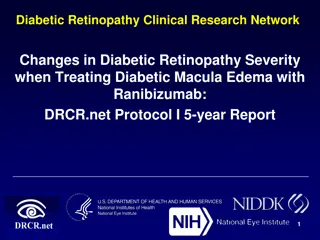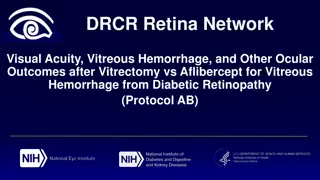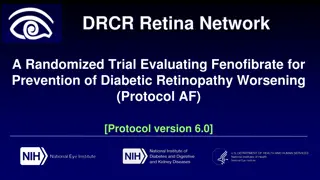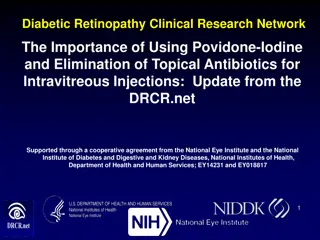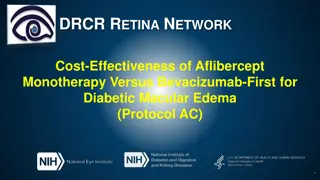
Retinal Nonperfusion and Diabetic Retinopathy Severity Study
Explore the association between retinal nonperfusion and diabetic retinopathy severity, focusing on peripheral lesions. The study assesses risk factors and outcomes using fluorescein angiography to evaluate disease progression over time.
Download Presentation

Please find below an Image/Link to download the presentation.
The content on the website is provided AS IS for your information and personal use only. It may not be sold, licensed, or shared on other websites without obtaining consent from the author. If you encounter any issues during the download, it is possible that the publisher has removed the file from their server.
You are allowed to download the files provided on this website for personal or commercial use, subject to the condition that they are used lawfully. All files are the property of their respective owners.
The content on the website is provided AS IS for your information and personal use only. It may not be sold, licensed, or shared on other websites without obtaining consent from the author.
E N D
Presentation Transcript
DRCR RETINA NETWORK UWF-FA Nonperfusion and Risk of DR Disease Worsening Over Time (Protocol AA)
Fluorescein Angiography Risk Factors Fluorescein angiography of the ETDRS area was historically studied in detail Only two (1F and 2F) FA 30 fields were evaluated in ETDRS Retinal periphery was not evaluated in the ETDRS 2
Objective Baseline Analysis To evaluate the association of retinal nonperfusion (NP) on UWF fluorescein angiography (FA) with diabetic retinopathy (DR) severity and predominantly peripheral lesions (PPL). 3
Outcomes Measured DRSS level evaluated within ETDRS fields on UWF-Color images PPL graded for each extended ETDRS field on UWF-color images and on UWF-FA Defined as DR lesions located primarily outside versus within the 7 standard ETDRS fields for any field of the retinal periphery UWF-FA images were also evaluated for: Total gradable area (mm2) Extent of retinal nonperfusion (mm2) Nonperfusion index (NPI; ratio of nonperfused to total gradable area)
Baseline DR Severity and Overall Nonperfusion 200 0.25 0.23 Mean Nonperfusion Area (mm2) Mean NPI Mean Nonperfusion Index 0.19 160 0.20 0.15 120 0.15 0.12 0.10 80 0.10 40 0.05 P = .002 0 0.00 No DR to Mild NPDR (N = 207) Moderate NPDR (N = 157) Mod. Severe NPDR (N = 91) Sev/ V. Sev NPDR (N = 167) PDR (N = 30) DR: diabetic retinopathy; NPDR: nonproliferative DR; PDR: proliferative DR: Sev/V.Sev: severe or very severe
BASELINE PPL AND OVERALL NONPERFUSION PPL on Color PPL on FA 0.30 0.30 180 180 Mean NPI (P = .65) Mean NPI (P < .001) Mean Nonperfusion Area (mm2) Mean Nonperfusion Area (mm2) Mean Nonperfusion Index Mean Nonperfusion Index 0.25 0.25 150 150 0.18 0.20 0.20 0.16 0.13 0.15 0.15 120 120 0.12 0.10 0.10 90 90 0.05 0.05 0.00 0.00 60 60 PPL Absent on Color (N = 396) PPL Present on Color (N = 256) PPL Absent on FA (N = 370) PPL Present on FA (N = 282) PPL: predominantly peripheral lesions
Nonperfusion by Retinal Zone and PPL (FA) P < 0.001 FA-PPL Absent (N = 370) FA-PPL Present (N = 282) 0.4 0.36 Mean Nonperfusion Index 0.3 P < 0.001 0.22 0.19 0.2 0.13 P = 0.38 0.1 0.04 0.04 0 Posterior pole (<10 mm) Mid-periphery (10-15 mm) Far periphery (>15 mm) PPL: predominantly peripheral lesions
Summary Worse DRSS severity was strongly associated with increases in nonperfusion. Nonperfusion identified on UWF-FA in these diabetic eyes was located primarily in the mid- and far- periphery that are not visualized by standard ETDRS FA imaging. No significant association between overall nonperfusion and presence of color-PPL was identified. Presence of PPL identified on UWF-FA has been shown to be associated with increasing nonperfusion that co-localizes with the retinal areas of nonperfusion. 8
Objective Longitudinal Analysis Assessment of whether extent of UWF-FA retinal nonperfusion (NP) is associated with increased rates of DR disease worsening over time If so, whether this effect is independent of known risk factors for ETDRS DRSS worsening and does this help explain the relationship between FA-PPL and DR disease worsening? 9
Primary Outcome Proportion of eyes experiencing DRSS worsening by 2 or more steps from baseline or receipt of DR treatment through 4 years Outcome assessed within the ETDRS fields on UWF color images Eyes receiving treatment with anti-VEGF, steroid, or vitrectomy for conditions other than DR were censored 10
Baseline Characteristics 508 Study Eyes* Nonperfusion on UWF-FA No NP Low NPI Medium NPI High NPI 9% 30% 30% 30% * Only eyes with NPDR on UWF-color and gradable NP on UWF-FA were included Eyes with measured NP were divided into 3 equally sized subgroups based on tertiles of overall NPI: low NP (NPI 0.028), medium NP (NPI >0.028 to 0.182), or high NP (NPI >0.182 to 0.861). 11
DR Disease Worsening and Overall Retinal Nonperfusion on UWF-FA 100% *Adjusted Hazard Ratio For 0.1-unit increase in NPI = 1.11 (95% CI = 1.02, 1.21); P = 0.02 No NP Low NPI Medium NPI High NPI Cumulative Proportion 80% 60% 46% 43% 38% 40% 20% 26% 0% 0 1 2 3 4 Visit in Years 34 108 115 104 No NP Low NPI Medium NPI High NPI 47 153 154 154 40 135 135 140 32 76 91 77 29 60 67 60 12 * Adjusting for baseline DRSS level on UWF-color images, % of total gradable area on UWF-FA, and correlation between 2 study eyes in the same participant
Secondary Diabetic Retinopathy Outcomes Over Time and Nonperfusion Adjusted Hazard Ratio (95% CI) * for every 0.1-unit increase in Overall NPI P value Development of PDR 1.16 (1.04, 1.29) .008 Development of vitreous hemorrhage 2 steps DRSS improvement 1.30 (1.14, 1.48) <.001 1.01 (0.87, 1.17) .92 * Adjusting for baseline DRSS level on UWF-color images, % of total gradable area on UWF-FA, and correlation between 2 study eyes in the same participant Due to low outcome proportions in the mild and moderate NPDR subgroups, the adjusted hazard ratio and P value were only estimated for eyes with moderately severe to very severe NPDR. 13
DR Disease Worsening Over Time with Retinal NP and FA-PPL Adjusted Hazard Ratio (95% CI) * For 0.1-unit Increase in NPI 1.14 (1.04, 1.24) P = .003 1.11 (1.02, 1.22) P = .02 For PPL Present vs. PPL Absent -- With adjustment for baseline DR severity and participant- level characteristics 1.89 (1.35, 2.63) P < .001 * Adjusting for baseline DRSS level on UWF-color images, % of total gradable area on UWF-FA, and correlation between 2 study eyes in the same participant. Participant-level systemic risk factors included age, diabetes type (excluding uncertain type), duration of diabetes, hemoglobin A1c, and albuminuria. 14
Summary Increasing baseline retinal NPI on UWF-FA is associated with higher risk of DRSS worsening or treatment over time, and secondary outcomes such as PDR development and vitreous hemorrhage over time. These associations are driven by nonperfusion located primarily in the posterior pole and mid-periphery. Although greater nonperfusion is also associated with the presence of FA-PPL, both nonperfusion and FA-PPL are independently associated with DRSS worsening or treatment even after adjusting for baseline ETDRS DRSS level and possible confounders in the multivariable analysis. 15
Discussion The Protocol AA dataset, containing longitudinal matched color and angiographic images, provides a rich opportunity to explore these kinds of novel risk factors for DR disease worsening that have not been previously addressed. The associations between disease worsening and retinal nonperfusion and FA-PPL support the increased use of UWF- FA to complement color fundus photography in future efforts for DR prognosis, clinical care, and research. 16

